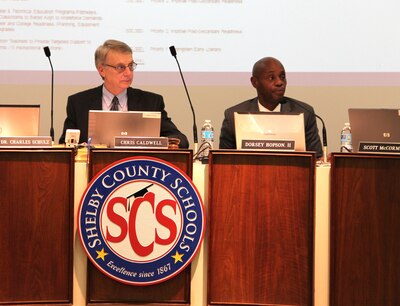When it comes to providing enough money to keep Shelby County Schools afloat, board member Stephanie Love likens Tennessee’s largest school system to a ship that has been navigating life-threatening storms.
The beleaguered district has been battered by wave after wave of budgetary challenges: the massive merger of city and county schools in 2013; six municipalities pulling out to start their own school systems in 2014; yearly takeovers of Memphis schools by the state-run turnaround district; and annual closings of aging school buildings that have too many needs and too few students.
But this year, the wind-whipped ship appears to be sailing into calmer waters.

“This will be one of the best budget years since the merger and demerger …,” Love said. “This year we are able to sit down and strategize.”
Indeed, when administrators roll out their proposed spending plan on Monday, the district will start the budget process in the black for the first time in years.
Superintendent Dorsey Hopson said the budget proposal will contain “unprecedented investments” for schools.
“After experiencing the largest school merger in history, we have stabilized our district and can shift our focus toward strategic investments in our schools,” Hopson said in a statement Friday. “Although we still believe that we are underfunded at the state level, we have worked diligently to maximize our limited resources.”
How Hopson and the school board will leverage the district’s newfound stability will be decided in the coming weeks as they target a budget vote for March 28.
The timeline for the process has been stepped up this year under Chief Financial Officer Lin Johnson, now starting his second budget season with Shelby County Schools. He and Hopson hope to present an approved budget in April to the Shelby County Board of Commissioners, which holds the purse strings for local public schools.
Teacher training, supports for failing schools, and adding school counselors and behavior specialists are among items on wish lists for leaders who are weary of storms and ready to make proactive investments.
The shift in thinking is a welcome change from last year, when Hopson kicked off the budget season facing an $86 million shortfall on the tails of $125 million in cuts the previous year.
After cutting positions, winning at $22 million funding boost from the county commission and dipping into reserves, the district crafted a $959 million budget for the current fiscal year, including a 3 percent raise for teachers. The ante up from from the county was a crucial win for local schools because the increase set a higher baseline for funding levels for years to come.
But lest anyone gets too giddy about this year’s prospects, board Chairman Chris Caldwell is quick to remind that the district still remains woefully underfunded.

“We may have a healthy fund balance, but in the bigger picture we don’t have healthy funding,” referring to the district’s funding lawsuit against the state. The suit, which is winding its way through the courts, charges the state with shortchanging Shelby County Schools by upwards of $100 million every year.
Still, the relative financial stability should open a fresh new conversation with county leaders about how Hopson and his team are doing to right the bloated district. Each year, county commissioners have asked Hopson to constrict its footprint. Last fall, the superintendent responded by unveiling a proposal to close, build and consolidate five schools into three.
Steve Basar, who chairs the commission’s finance committee, says it’s time to take the long view.
“This is your third year (since the de-merger) and you’ve had a lot of turnover in the staff. It’s realistic that you weren’t able to plan because the landscape has been changing so much,” said Basar. “Now we need to look what’s the footprint going to look like for the next 50 years.”
That likely means more school closures on the horizon. But the process has slowed dramatically under a strategic plan unveiled last month by Hopson to determine which struggling schools to invest in based on enrollment, academic performance and maintenance costs. Interventions will take cues from the district’s Innovation Zone, the district’s expensive turnaround model, with the expectation of steady academic improvement.
“This is the process the board was hoping for,” Caldwell said. “Sometimes decisions were made looking retroactively, but this is a move on the front end.”
Love said Hopson’s plan reflects more optimism about finances.
“Being that we don’t have a deficit, we’re able to do the superintendent’s summer academy,” she said, referring to this summer’s intervention program for 5,000 students). “We’re about to put more money into schools that haven’t received support from the Achievement School District or the iZone.”
This school year also marks the depletion of a historic $90 million grant from Bill & Melinda Gates Foundation that changed the way the district evaluates and trains teachers. District spokeswoman Natalia Powers says the upcoming budget will need to bolster professional development so the district can house its own teacher training rather than contracting that service out.

